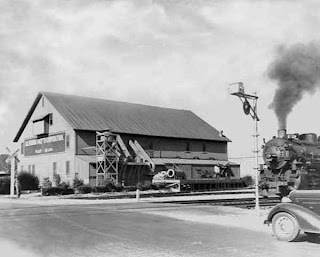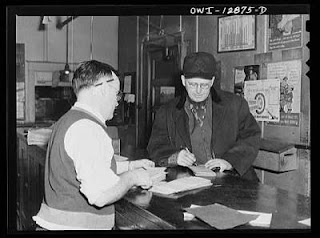Jason: "Jim Providenza's Santa Cruz Northern."
Me: "You know you'll be running over this crossing here tomorrow, except in the opposite direction, right?"
Although hosting an operating session on my layout was my Big Event at ProRail, I also got a chance to operate on one of the other layouts - Jim Providenza's Santa Cruz Northern layout. Jim's layout is famous in model railroad circles. When interest in model railroad operations picked up in the late 1990's-about the same time that DCC control systems made running multiple trains on the same track trivial-Jim's articles in Model Railroader and other magazines about running trains with radios, dispatchers, station agents, and lots of meets got a lot of well-deserved attention and probably spurred a flock of great model railroad layouts for operations.
It didn't hurt, of course, that he's got a nicely scenicked layout with a long track run, all fit in half of a two car garage. Check out this video for a chance to see a video of the layout, though be aware the first minute focuses on the staging shelf across the garage from the best part of the layout.
The radios went away long ago, though. Now, Jim keeps trains safe via Timetable and Train Order Operation (TT&TO), the way that railroads in the first half of the 20th century kept trains from crashing into each other. Train orders, essentially, are logic puzzles that railroaders must solve before they're allowed to go home at night. All trains get a set of orders describing who wins out when two trains might occupy the same tracks. The orders are sent via telegraph to all trains (via telegraph operators at stations along the lines). The railroad crews interpret the orders (using the train orders, the rule book, and the timetable) to decide whether it's safe to move to the next siding, or if the other train might be coming at them. It's a great system when communication is challenging, but train orders required literate and sharp railroad crews to interpret the orders correctly.
Train orders also required a chain-smoking, caffeine-laden dispatcher sitting in an office somewhere with a telegraph key, papers for recording the orders sent and current location of trains, and a forceful personality to confidently hand out the orders.
Sadly, Jim didn't have one of those sorts of people, so I got to dispatch. And honestly, it was great fun; though I'd done it before, the SCN is larger and more elaborate than other layouts, so it made me think a lot more about the orders I was giving, whether I was planning ahead enough, and whether I was really writing safe orders. (Answer in at least one case: NO.)
I did poorly in one dimension: TT&TO was designed for difficult communication, so the best plan is to give out complete orders to several trains, and let them work out the details. "Train A gets to go down the hill first after 9:00; Train B can go uphill and Train C can go downhill as long as they don't get in A's way." This kind of a rule means that train B can start trying to get up the hill before 9:00 if they know there's a place to meet train A; once train A gets down the hill, then B and C rely on the rulebook to realize the train going up the hill always gets to go first without other priorities.
Assuming, of course, that all three trains realize there's a passenger train on the timetable going up the hill at 8:00, and has priority over all of them.
I instead tried to keep control and give permission only when I knew there was space - an appropriate scheme in the radio era of the 1970's, but an awful waste of paper. The cement train crew laughed about the stack of nine orders they'd needed to get their train up and back. I also ended up with three trains stuck at Fallon at the top of the hill towards the end of the session, but somehow they all got untangled just fine.
Jim's layout was a special place to visit for another reason: like me, he models the area from San Jose to Santa Cruz. He does have his own twist; Jim not only models the 1970's when he started railfanning, but he also models a personalized Santa Clara Valley where the Western Pacific had built a railroad going over the mountains. That gave him the freedom to model rough locations and the feel of the Santa Cruz Mountains without having to precisely model specific towns or the switchman's shanty next to the mainline switch at Diridon Station.
But on the edge of his Mac St. Yard in San Jose, just past the yard limits, you'll find the Southern Pacific crossing and interchange tracks. If you turn aside at the crossing and start walking up the SP tracks, you'll be on my Vasona Branch, looking at the Del Monte Cannery on one side, and Standard Oil's depot on the other. If you turn around and walk back down the unconnected WP tracks at the crossing, you'll be back here at a very busy SCN mainline looking at the Babbage Computer Company. Either way you turn, the smell of cooking tomatoes from the Del Monte cannery wins out over any other sensations.
[Photos from the SCN operating session this week are mine. First photo: SCN panorama. Second photo: after Fallon was unclogged. Third photo: SP Interchange on the SCN. If model railroad operations sounds interesting, drop me a note, or come to the Bay Area Layout Design and Operations meet, held every year the week before the Super Bowl.]

















